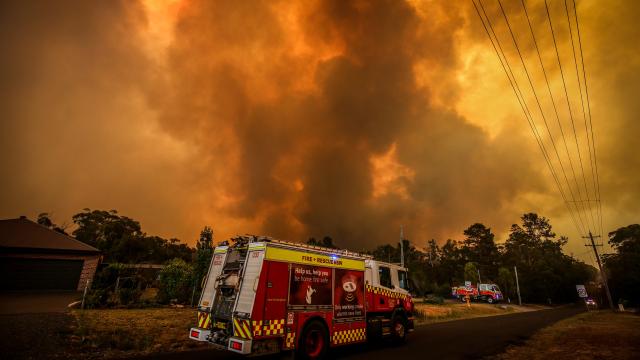Smoke from Australia’s record-breaking 2019-20 bushfire season wasn’t just a disaster for wildlife. The fires and smoke also killed hundreds of people and sent thousands more to the hospital for urgent cardiovascular and respiratory issues, costing the country nearly $2 billion in healthcare costs, a new study found.
The findings come as the West burns, unleashing toxic air across the region, and they send a stark warning of what the future could hold for fire-prone areas. Fires are a natural feature in Mediterranean climates like California and Australia. But as global temperatures rise, fire seasons are becoming longer and more severe. Australia’s latest bushfire season burned a record of nearly 8 million hectares over six months.
For the study, published in Nature Sustainability on Monday, researchers aimed to calculate the number of hospitalizations and deaths caused by tiny bits of particulate matter known in air qualityspeak as PM2.5 from the Australian bushfires. They did so by examining medical records for each bushfire season — October through March — since 2002, looking specifically at spikes in admissions to emergency rooms for asthma, entry into hospitals for cardiovascular and respiratory disorders, and deaths from issues in either of these categories. They focused specifically on seven populous areas in Australia, which according to public air quality data, see high concentrations of PM2.5 when fires burn.
The particulate matter comes courtesy of smoke, which spreads far and wide during fires. But the most recent bushfire season was on another level, sending smoke record-breaking heights and circumnavigating the globe. When people inhale that smoke, particulate matter can get into their hearts and lungs, setting off all sorts of health problems. PM2.5 is of particular concern because those particles can get deepest into the lungs, and fires produce a lot of them.
Across the regions analysed, the researchers estimate that last season’s fires caused 429 smoke-related premature deaths, 3,230 hospitalisations for heart and breathing disorders, and 1,523 emergency room admissions for asthma.
Though economic assessments of fires are frequently performed to determine the costs of fire-related injuries, losses of homes and infrastructure, and firefighting, they don’t often include the cost of health impacts. But the new study shows that the toll of the blazes’ smoke pollution on locals’ health is also dramatically increasing, which has massive economic implications that should also be considered.
By examining national data on the average costs of hospital stays, average lost economic productivity during hospital stays, and the economic value of a statistical life, the authors were able to estimate the fiscal implications all of this illness and death had on the country of Australia. They pegged the cost at $2 billion.
That healthcare toll, the authors found, is by far the largest ever seen from a bushfire season in Australia. When they calculated the cost of other seasons, they found that the second highest was the 2002-03 season, which cost $566 million. Even more strikingly, the toll of 2019-20 was more than nine times higher than the median annual bushfire-associated healthcare costs of the previous 19 years, which is just $211 million.
The scientists note that this estimate is highly conservative, as their research doesn’t account for the probable ongoing costs of medication, ambulance services, reduced economic productivity, or mental health burden. Research also show that bushfire smoke can cause health problems for unborn children. These, too, are important contributors to the economic impacts of fire emergencies.
The new study could inform policy not only in Australia, but also in other parts of the world that experience fire seasons. Researchers, for instance, could employ the same methods to determine the economic toll of health-related impacts for this and other California wildfire seasons.
The research comes as public health organisations across Australia are calling for the impacts of the climate crisis to be considered as a key part of the national preventative health strategy, and for the country to adopt stricter clean energy standards and adaptation methods. The authors of the new study call for climate action, too.
“Managing wildfire smoke is thus a global policy challenge that requires multiple strategies ranging from global climate stabilisation to local-scale fuel management,” the study says. “The direct and manifest health impacts of wildfires on large human populations are a powerful reason to improve climate change mitigation and achieve sustainable wildfire management.”
